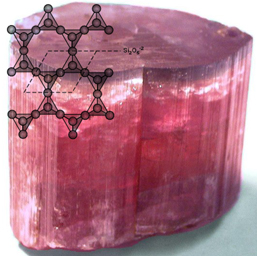

Aquamarine ("sea water") is a blue or blue-green beryl, along with emerald (green stones), morganite (pink stones) and heliodor (yellow stones). Beryls are members of the cyclosilicate group, with Si6O18 (a ring of six of SiO3) as the chemical structure. Beryl is beryllium aluminum silicate and common beryl is an important source for beryllium. Gem-quality aquamarine is typically found in pegmatite cavities or alluvial deposits. In the 19th century, sea-green aquamarine was highly valued, but in more recent times the sky-blue crystals have been preferred. The blue color is from traces of iron, and many aquamarines are heated to enhance the blue color.
Dumortierite looks like a cross between sodalite and zoisite, with rich navy blue color interspersed with matrix. It occurs in pegmatites and aluminmum-rich metamorphic rock and is generally found as aggregates. Localities include the Czech Republic and Norway and Rocky Mountain states in the US. Much of our dumortierite is from Colorado and Montana.
Emerald is a green beryl, along with aquamarine (blue to blue-green stones), morganite (pink stones) and heliodor (yellow stones). Beryls are members of the cyclosilicate group, with Si6O18 (a ring of six of SiO3) as the chemical structure. Rich deposits of gem-quality emerald are found in Columbia in thin veins of white calcite or quartz. Emeralds are also found in the Ural mountains of Russia in mica or chlorite schnist. The green color results from trace amounts of chromium. Flawless emeralds are rare, and stones are often oiled to fill in and disguise cracks.
Garnet includes a large collection of gemstone species, all conforming to the general formula (SiO4)3. Almandine is an iron aluminum garnet and is the most common. The name comes from Alabanda, Turkey where it has been cut from antiquity. The color tends to be a more pink-red than pyrope garnet. Rhodolite garnet is a mix of almandine and pyrope, and pyrope is dark red. Spessartine is named for Spessart, Bavaria; it is a manganese aluminum garnet and orange-red in color. Grossular garnet is named for the Latin grossularia "gooseberry", in reference to the gooseberry-green color. It is a calcium aluminum garnet, and it can be white or honey colored as well as green. When it is reddish-brown, it is known as hessonite garnet (color due to iron and manganese inclusions). Transparent grossular garnet is marketed as tsavorite and it can rival emeralds or diopside in terms of clear deep green.
Goshenite is a colorless or pale colored variety of beryl, named after where it was first found (Goshen, Massachusetts). It is the least common gem beryl and typically found in pegmatites.
Grandidierite is a rare mineral from southern Madagascar, named for its explorer, French Alfred Grandidier. It displays strong trichroic pleochroism, meaning that it can show three different colors depending on the viewing angle: dark blue-green, colorless (sometimes a very light yellow), or dark green. It has low iron content relative to magnesium, leading to the green and blue-green color. Gemstone quality samples are very rare, though a new deposit outside the town of Tranomaro, near the original locality of Andrahomana, was identified in 2016, leading to more gemstones on the market.
Iolite is the gemstone name of the mineral cordierite, also a member of the cyclosilicate group. It has been called "water sapphire" in reference to the deep blue-violet color. The crystals are prismatic so the best blue color is observed along the crystal's long axis. It is found in schists and gneisses, and sometimes in pegmatites and quartz veins. Sri Lanka and Myanmar are primary sources for high-grade iolite.
Morganite is a pink beryl, along with aquamarine (blue to blue-green stones), emerald (green stones) and heliodor (yellow stones). Beryls are members of the cyclosilicate group, with Si6O18 (a ring of six of SiO3) as the chemical structure. Morganite is found in lithium rich pegmatites with lepidolite and tourmaline in locations in Brazil and Pala, California. The pink color comes from cesium or manganese, and stones with a yellow or orange tinge are sometimes heat-treated to enhance the pink color.
Tourmaline is the name given to a family of borosilicate minerals with many variations found with the same basic crystal structure (Si6O18). There are over 10 species of tourmaline, including elbaite (high quality crystal with a variety of colors), dravite (the more common brown tourmaline), and schorl (black tourmaline). The most common colors associated with gemstone tourmaline (pinks, magentas, teal blue and green) are found in elbaite. Rubellite is the pink-purple variety, verdelite is green, and indicolite is blue-green. Watermelon tourmaline refers to stones with a pink center surrounded by green. The most beautiful gemstones come from Brazil, the Pala district near San Diego, Madagascar and Mozambique.